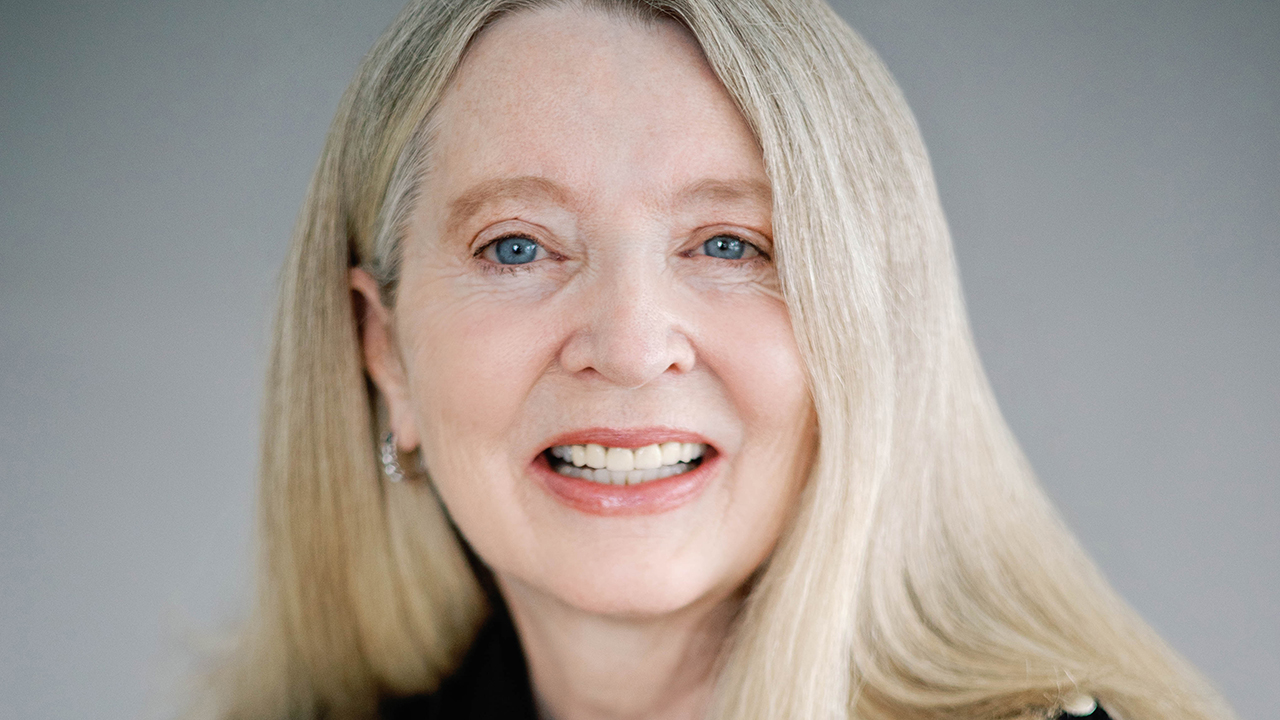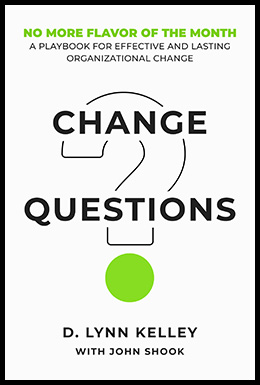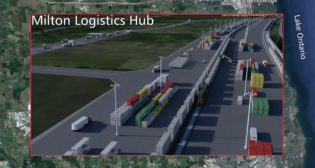
Sustaining Organizational Change
Written by Sonia Bot Contributing Editor, With D. Lynn Kelley
“Every methodology I have seen has a step-by-step process. However, no two changes are the same; every change is different.” – D. Lynn Kelley. Gabriella Santos Photography
RAILWAY AGE, OCTOBER 2023 ISSUE: Change is not for the faint of heart. A new book, Change Questions, tells us how to implement it, and how to make it stick.

The pace of organizational change has been increasing. Unfortunately, most change activities fail to deliver anticipated results. Those that do often fail to sustain such change. The recently released change management book, Change Questions, A Playbook for Effective and Lasting Organizational Change, by D. Lynn Kelley with John Shook, addresses these critical issues by providing a proven process with a strong record of sustainment that can be used by anyone responsible for implementing organizational change. The book includes a case study with examples and stories of transformation at Union Pacific when Kelly was Senior Vice President of Supply Chain and Continuous Improvement. The initiative resulted in a dramatic increase in operational performance and a 96% sustainment rate over hundreds of change initiatives.
Retired from UP, Kelley is working for Brown Brothers Harriman’s private equity group, advising on railroad investments and manufacturing. With a Ph.D in evaluation and research, she has guided large companies such as Textron and UP through change management. She has held leadership roles in supply chain manufacturing, engineering and continuous improvement across diverse industries at a global scale.
SONIA BOT: What do you see as the unique value that your book and change questions methodology offer?
LYNN KELLEY: Every methodology I have seen has a step-by-step process. However, no two changes are the same; every change is different. Therefore, the methodology should be able to ebb and flow and adjust to your own specific needs. The questions approach lets everyone review these questions and decide what’s appropriate for them and their change. They end up with a customized approach.
SB: Railroads are an entrenched industry and there’s some beauty to the entrenchment, but they need to keep moving forward. There are new entrant competitors coming, but there’s also extensive union involvement and there’s a skill and an art in terms of how to deal effectively with all different parts of a railroad or that type of environment. You can also say the same about complexity when you factor into your change initiative any external parties or other legal entities that come into your change initiative such as, for example, external business partners, suppliers, regulators and customers. Too often, 60% to 70% of change efforts fail, but it doesn’t have to be that way. You’ve also experienced sustainable change.
LK: So often we implement change as if failure is not an option, or if we mention failure, it will jinx it, rather than proactively recognizing that there is a high probability that it will fail unless we systematically approach the change. When I left Textron, we were at a 90% sustainment rate for our changes across all industries—35,000 employees, 32 countries and hundreds of different initiatives a year. It proved to me that just taking time before we implement a major change really pays the dividends. We measured it the same way at UP When I left there, we had a 96% sustainment rate, where much of the work included union employees in the field, and what they were doing to increase productivity and network velocity.
SB: Many organizations and change practitioners tend to get stuck in a method and apply it generically as a checklist while missing key things, or they take shortcuts and cut out important steps, or they simply tinker, flying by the seat of their pants. How do Change Questions help reduce this risk?
LK: When I developed Change Questions, I kept pulling in anything that was relevant. I wound up with 11 questions. It’s bigger than your normal model, but unless you have a super complex change, you probably won’t address every question. The result is that you don’t overproduce too complex of an implementation plan, or underproduce one that’s not complex enough. You end up with a plan that’s “just right.” That was my goal with Change Questions.
SB: You provide many vivid case studies of your experience at UP, where your mandate was based on Lean being the underlying methodology. Lean is a way of thinking about creating needed value with fewer resources and less waste, a practice consisting of continuous experimentation. We need to recognize that Lean thinking and Lean practice occur together. There are 11 Change Questions. Let’s spotlight two. First Change Question: What is your value driven purpose for the change?
LK:This is a powerful question on many fronts. It includes two elements: value and purpose. “Flavor of the month” can occur when many big organizational changes get rolled out, and we don’t often define the value we expect to get from the change. With Change Questions, we do it as the first question. Later on, we’ll be trying to measure the change to see if we really are getting the value we expect. A value-driven purpose statement starts to give us alignment and set us on a direction. For example, railroads live and die by velocity. They want to keep things moving. Union Pacific, like most railroads, has two main groups that work on velocity: dispatchers, and the transportation folks in the field. There are pairs of dispatching and transportation managers who own the corridors.
We found at UP that, though you may think they’re aligned on purpose because they both had velocity as a goal, sometimes transportation would suboptimize dispatch velocity by making their own velocity better, and vice versa. We started pairing them up on that shared goal with a shared purpose. Velocity immediately started to go up. We found that people in the field felt sometimes the speed limits were too low. And over the course of 150 years, maybe a curve had been straightened or a bridge had been added, but nobody went back to dispatch in every single circumstance and changed the speed limit. An astute pair got out, looked at everything, and found that they could go through their corridor and increase speed dramatically. Everybody else did it, and velocity improved. It was fantastic because we were aligned on purpose.
SB: Second Change Question: How will you establish a supportive management system with the appropriate leadership behaviors?
LK: One of the top reasons that change initiatives fail is lack of top leadership support. Think of a management system as the infrastructure that might be working against your change, things like how we’re measured. Think of the example I just gave you. Each of those folks on velocity were being measured through their own department, which was working against the overall goal. It could be how you’re measured, how you’re promoted, the organization chart, etc. We need to see if there’s anything that’s conflicting with the change we want to initiate.
At UP, we found we needed to teach proactive problem solving, addressing problems before they become a crisis. A railroad experiences a crisis daily, and we love and reward the firefighters, the people who can get us out of emergencies. We don’t say very much about the people that avoid the fires. We needed to find a way to reward not only the firefighters, but the people who proactively eliminate those fires from happening in the first place.
The second part of that Change Question involves leadership behaviors. The research doesn’t just say that it fails if leadership doesn’t support it. It mostly refers to visible leadership behaviors where employees get more than lip service. Employees can see that leaders are supportive of change. At UP, we did something called catchball. We went to leaders and said, “This is the change we’re going to implement. How can you show your people you support this? What could you visibly do?” But it’s something we have to do delicately so that mentally and psychologically, leadership is engaged in visualizing themselves, supporting the change. That’s a big step in terms of change behavior and internal buy-in.
SB: One of the techniques you describe is the “20-60-20 rule.” It’s very effective.
LK: No matter what change it is, 20% of people will be open. They’re the change agents, the early adopters. Then, 60% will be neutral. They’re just going to wait around, not take a strong stance. The remaining 20% will resist. And if you just roll something out without any preparation, the negative people will have a loud voice in trying to dissuade people from making the change.
Yet, I also found you could use that curve to your advantage. Those who resist change are going to pull neutrals over it in the wrong direction. You have to drive momentum in the positive direction. At Union Pacific, in almost every situation, we tried some type of a pilot, an experiment, a simulation. If you get a spark of success, you immediately glom onto it and have the CEO talk about it. Everybody is listening, and the neutrals are saying, “We want that.” I strongly recommend that for anybody implementing widescale organizational change.
I want to briefly describe a panel survey we did at Union Pacific. We had a lot of quick and easy ways to check if we were succeeding, but we thought we’d adopt an idea from the medical field, which does longitudinal studies. We randomly selected 400 people for a stratified sampled, which meant that the sample was representative of the demographic proportions of the population. We reached out and said, “We’re doing this new initiative over the next four years. Will you sign up so we can send you a survey every six months that takes 10 to 15 minutes? Your results will always be anonymous, and you can mail them in, go on a website—however you want to complete your survey.”
If we had done the whole population, we would’ve gotten maybe a 10% to 12% response rate. You can’t make inferences with that. We got an 85% response rate over four years, and we could see where the change was working, where it wasn’t working, where leaders supported it and where they didn’t. By year three, we were able to correlate that with our top-level key performance indicators (KPIs). We saw that the top service units who bought into our program were the top five in terms of operating results and KPIs. Statistically, all their metrics were better than the other ones.
We did a spot check. One service unit that was always at the bottom saw this and asked us to help. Within six months they went to the top of the KPI list. So in terms of operating results, it worked. The Change Questions helped sustain and course-correct. It was really rewarding to see that.
SB: That’s a great testament. I find that, depending on the starting capability of the organization, sustained improvement ranges can be between 20% to 80%. If the approach is done properly, especially for the more complex changes, it requires having some experienced leaders and practitioners on the team, whether they’re outsourced or in-sourced, with both having academic theory and deep practical experience, with a proven track record as well.
Change Questions is available in print, on Kindle and on audiobook at amazon.com.

Sonia Bot, chief executive of The BOT Consulting Group Inc., has played key roles in the inception and delivery of several strategic businesses and transformations worldwide. She’s navigated through downsizing, right-sizing, de-regulations, SEC investigations, and economic downturns/scale-ups, let alone working through one of the most high-profile global corporate bankruptcies in the world. As a veteran innovator, change agent, high tech executive, and advisor she’s enabled organizations to deliver breakthrough results along with providing them a foundation to continue to excel. Her solid approaches to the evolution of companies and industries are game-changers that drive innovation and competitive advantage. Her experience ranges from Fortune 500 corporations to medium-sized ones, and start-ups. Sonia’s contributions to the rail industry are as a leader and a visionary who is passionate about taking railroading into the next generation. Sonia can be reached at [email protected] or Sonia Bot | LinkedIn.
Rail Group on Air Podcast: Change Questions, with D. Lynn Kelley and Sonia Bot
Digital Workbook: Digital Workbook — Change Questions
Change Questions Website: Change Questions
Lynn Kelley: D. Lynn Kelley, PhD | LinkedIn -or- Change Questions
Sonia Bot: Sonia Bot | LinkedIn -or- [email protected] Attention: Sonia Bot



